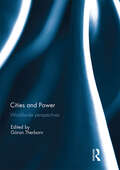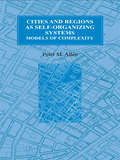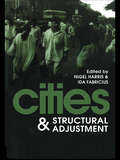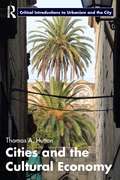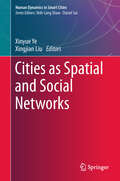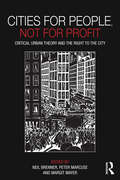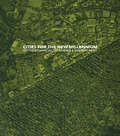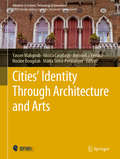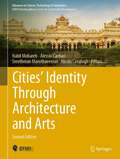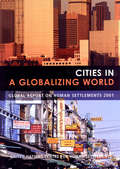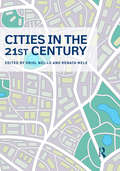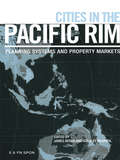- Table View
- List View
Cities and Power: Worldwide Perspectives
by Göran TherbornWhat do cities tell us about power? How does power shape cities? These are the main questions answered by a multidisciplinary set of eminent urban scholar in crisp articles on capital cities from around the world, from Buenos Aires to Tokyo, from Jakarta to Moscow. Focus is on contemporary cities and their manifestations and representations of power, though often with a historical grounding, and the collection also includes an example of archaeological urban analysis, from northern Mesopotamia. Through its variety of approaches by leading scholars of the field, and its variety of cities with their different histories and their diverse national contexts and political organization the book gives a uniquely insightful and easily accessible world overview of cities of power.This book was published as a special issue of the International Journal of Urban Sciences.
Cities and Power: Worldwide Perspectives
by Göran TherbornWhat do cities tell us about power? How does power shape cities? These are the main questions answered by a multidisciplinary set of eminent urban scholar in crisp articles on capital cities from around the world, from Buenos Aires to Tokyo, from Jakarta to Moscow. Focus is on contemporary cities and their manifestations and representations of power, though often with a historical grounding, and the collection also includes an example of archaeological urban analysis, from northern Mesopotamia. Through its variety of approaches by leading scholars of the field, and its variety of cities with their different histories and their diverse national contexts and political organization the book gives a uniquely insightful and easily accessible world overview of cities of power.This book was published as a special issue of the International Journal of Urban Sciences.
Cities and Regions as Self-Organizing Systems: Models of Complexity
by Peter M. AllenA clear methodological and philosophical introduction to complexity theory as applied to urban and regional systems is given, together with a detailed series of modelling case studies compiled over the last couple of decades. Based on the new complex systems thinking, mathematical models are developed which attempt to simulate the evolution of towns, cities, and regions and the complicated co-evolutionary interaction there is both between and within them. The aim of these models is to help policy analysis and decision-making in urban and regional planning, energy policy, transport policy, and many other areas of service provision, infrastructure planning, and investment that are necessary for a successful society.
Cities and Regions as Self-Organizing Systems: Models of Complexity (Environmental Problems And Social Dynamics Ser. #Vol. 1)
by Peter M. AllenA clear methodological and philosophical introduction to complexity theory as applied to urban and regional systems is given, together with a detailed series of modelling case studies compiled over the last couple of decades. Based on the new complex systems thinking, mathematical models are developed which attempt to simulate the evolution of towns, cities, and regions and the complicated co-evolutionary interaction there is both between and within them. The aim of these models is to help policy analysis and decision-making in urban and regional planning, energy policy, transport policy, and many other areas of service provision, infrastructure planning, and investment that are necessary for a successful society.
Cities And Structural Adjustment
by Nigel Harris Ida FabriciusThis work addresses the challenge faced in the management of major cities throughout the world as they adjust to economic reform and, in particular, to becoming more open to the processes operating in worldwide markets. Such processes have already had some dramatic effects on large cities in developed and developing countries - the rapid decline in manufacturing in older industrial cities and the emergence of the servicing city are but two of the more striking outcomes. Based on substantial case studies of cities in the developed and the developing world - Sheffield, Barcelona, Lille, Mexico City, Monterrey, Santiago de Chile, Bogota, Kingston Jamaica and Johannesburg - themes are drawn out, extending from structural economic change to policy reactions, new city initiatives, management, planning and finance.
Cities And Structural Adjustment
by Nigel Harris Ida FabriciusThis work addresses the challenge faced in the management of major cities throughout the world as they adjust to economic reform and, in particular, to becoming more open to the processes operating in worldwide markets. Such processes have already had some dramatic effects on large cities in developed and developing countries - the rapid decline in manufacturing in older industrial cities and the emergence of the servicing city are but two of the more striking outcomes. Based on substantial case studies of cities in the developed and the developing world - Sheffield, Barcelona, Lille, Mexico City, Monterrey, Santiago de Chile, Bogota, Kingston Jamaica and Johannesburg - themes are drawn out, extending from structural economic change to policy reactions, new city initiatives, management, planning and finance.
Cities and Territories of the Western Roman Empire: 4th Century BC to the 3rd Century AD
by Ricardo González-VillaescusaThis book showcases the unique shape of urban development that took hold during the Roman Empire, beginning in the Mediterranean basin before spreading out across Europe, and offers a fresh perspective on the cities and territories of the Roman West.With the expansion of Rome came a particular form of social organisation: the Roman city. This book provides a basic introduction to Roman cities, not through the lens of architecture and urbanism, but from a social, legal, cultural, spatial, and functional perspective. It focuses on the Roman civitas – the city and its territory – as the spatial model par excellence of Roman colonialism and expansion. Exploring primarily the cities and territories of the Western Empire, such as the Iberian Peninsula, Gaul, and Britain, González-Villaescusa revives from their ruins those central places that facilitated the circulation of people, goods, and information, forming the large urban network of a unified imperial territory.Cities and Territories of the Western Roman Empire: 4th Century BC to the 3rd Century AD is suitable for school and university students, as well as the general reader interested in the subject of Roman cities in the Western Empire.
Cities and Territories of the Western Roman Empire: 4th Century BC to the 3rd Century AD
by Ricardo González-VillaescusaThis book showcases the unique shape of urban development that took hold during the Roman Empire, beginning in the Mediterranean basin before spreading out across Europe, and offers a fresh perspective on the cities and territories of the Roman West.With the expansion of Rome came a particular form of social organisation: the Roman city. This book provides a basic introduction to Roman cities, not through the lens of architecture and urbanism, but from a social, legal, cultural, spatial, and functional perspective. It focuses on the Roman civitas – the city and its territory – as the spatial model par excellence of Roman colonialism and expansion. Exploring primarily the cities and territories of the Western Empire, such as the Iberian Peninsula, Gaul, and Britain, González-Villaescusa revives from their ruins those central places that facilitated the circulation of people, goods, and information, forming the large urban network of a unified imperial territory.Cities and Territories of the Western Roman Empire: 4th Century BC to the 3rd Century AD is suitable for school and university students, as well as the general reader interested in the subject of Roman cities in the Western Empire.
Cities and the Cultural Economy (Routledge Critical Introductions to Urbanism and the City)
by Thomas A. HuttonThe cultural economy forms a leading trajectory of urban development, and has emerged as a key facet of globalizing cities. Cultural industries include new media, digital arts, music and film, and the design industries and professions, as well as allied consumption and spectacle in the city. The cultural economy now represents the third-largest sector in many metropolitan cities of the West including London, Berlin, New York, San Francisco, and Melbourne, and is increasingly influential in the development of East Asian cities (Tokyo, Shanghai, Hong Kong and Singapore), as well as the mega-cities of the Global South (e.g. Mumbai, Capetown, and São Paulo). Cities and the Cultural Economy provides a critical integration of the burgeoning research and policy literatures in one of the most prominent sub-fields of contemporary urban studies. Policies for cultural economy are increasingly evident within planning, development and place-marketing programs, requiring large resource commitments, but producing – on the evidence – highly uneven results. Accordingly the volume includes a critical review of how the new cultural economy is reshaping urban labour, housing and property markets, contributing to gentrification and to ‘precarious employment’ formation, as well as to broadly favorable outcomes, such as community regeneration and urban vitality. The volume acknowledges the important growth dynamics and sustainability of key creative industries. Written primarily as a text for upper-level undergraduate and Masters students in urban, economic and social geography; sociology; cultural studies; and planning, this provocative and compelling text will also be of interest to those studying urban land economics, architecture, landscape architecture and the built environment.
Cities and the Cultural Economy (Routledge Critical Introductions to Urbanism and the City)
by Thomas A. HuttonThe cultural economy forms a leading trajectory of urban development, and has emerged as a key facet of globalizing cities. Cultural industries include new media, digital arts, music and film, and the design industries and professions, as well as allied consumption and spectacle in the city. The cultural economy now represents the third-largest sector in many metropolitan cities of the West including London, Berlin, New York, San Francisco, and Melbourne, and is increasingly influential in the development of East Asian cities (Tokyo, Shanghai, Hong Kong and Singapore), as well as the mega-cities of the Global South (e.g. Mumbai, Capetown, and São Paulo). Cities and the Cultural Economy provides a critical integration of the burgeoning research and policy literatures in one of the most prominent sub-fields of contemporary urban studies. Policies for cultural economy are increasingly evident within planning, development and place-marketing programs, requiring large resource commitments, but producing – on the evidence – highly uneven results. Accordingly the volume includes a critical review of how the new cultural economy is reshaping urban labour, housing and property markets, contributing to gentrification and to ‘precarious employment’ formation, as well as to broadly favorable outcomes, such as community regeneration and urban vitality. The volume acknowledges the important growth dynamics and sustainability of key creative industries. Written primarily as a text for upper-level undergraduate and Masters students in urban, economic and social geography; sociology; cultural studies; and planning, this provocative and compelling text will also be of interest to those studying urban land economics, architecture, landscape architecture and the built environment.
Cities as Spatial and Social Networks (Human Dynamics in Smart Cities)
by Xinyue Ye Xingjian LiuThis book reports on the latest, cutting-edge scholarship on integrating social network and spatial analyses in the built environment. It sheds light on conceptualization and Implementation of such integration, integration for intra-city level analysis, as well as integration for inter-city level analysis. It explores the use of new data sources concerning human and urban dynamics and provides a discussion of how social network and spatial analyses could be synthesized for a more nuanced understanding of the built environment. As such this book will be a valuable resource for scholars focusing on city-related networks in a number of ‘urban’ disciplines, including but not limited to urban geography, urban informatics, urban planning, urban sociology, and urban studies.
Cities for People, Not for Profit: Critical Urban Theory and the Right to the City
by Neil Brenner Peter Marcuse Margit MayerThe worldwide financial crisis has sent shock-waves of accelerated economic restructuring, regulatory reorganization and sociopolitical conflict through cities around the world. It has also given new impetus to the struggles of urban social movements emphasizing the injustice, destructiveness and unsustainability of capitalist forms of urbanization. This book contributes analyses intended to be useful for efforts to roll back contemporary profit-based forms of urbanization, and to promote alternative, radically democratic and sustainable forms of urbanism. The contributors provide cutting-edge analyses of contemporary urban restructuring, including the issues of neoliberalization, gentrification, colonization, "creative" cities, architecture and political power, sub-prime mortgage foreclosures and the ongoing struggles of "right to the city" movements. At the same time, the book explores the diverse interpretive frameworks – critical and otherwise – that are currently being used in academic discourse, in political struggles, and in everyday life to decipher contemporary urban transformations and contestations. The slogan, "cities for people, not for profit," sets into stark relief what the contributors view as a central political question involved in efforts, at once theoretical and practical, to address the global urban crises of our time. Drawing upon European and North American scholarship in sociology, politics, geography, urban planning and urban design, the book provides useful insights and perspectives for citizens, activists and intellectuals interested in exploring alternatives to contemporary forms of capitalist urbanization.
Cities for People, Not for Profit: Critical Urban Theory and the Right to the City
by Neil Brenner Peter Marcuse Margit MayerThe worldwide financial crisis has sent shock-waves of accelerated economic restructuring, regulatory reorganization and sociopolitical conflict through cities around the world. It has also given new impetus to the struggles of urban social movements emphasizing the injustice, destructiveness and unsustainability of capitalist forms of urbanization. This book contributes analyses intended to be useful for efforts to roll back contemporary profit-based forms of urbanization, and to promote alternative, radically democratic and sustainable forms of urbanism. The contributors provide cutting-edge analyses of contemporary urban restructuring, including the issues of neoliberalization, gentrification, colonization, "creative" cities, architecture and political power, sub-prime mortgage foreclosures and the ongoing struggles of "right to the city" movements. At the same time, the book explores the diverse interpretive frameworks – critical and otherwise – that are currently being used in academic discourse, in political struggles, and in everyday life to decipher contemporary urban transformations and contestations. The slogan, "cities for people, not for profit," sets into stark relief what the contributors view as a central political question involved in efforts, at once theoretical and practical, to address the global urban crises of our time. Drawing upon European and North American scholarship in sociology, politics, geography, urban planning and urban design, the book provides useful insights and perspectives for citizens, activists and intellectuals interested in exploring alternatives to contemporary forms of capitalist urbanization.
Cities for Smart Environmental and Energy Futures: Impacts on Architecture and Technology (Energy Systems)
by Stamatina Th. Rassia Panos M. PardalosCities for Smart Environmental and Energy Futures presents works written by eminent international experts from a variety of disciplines including architecture, engineering and related fields. Due to the ever-increasing focus on sustainable technologies, alternative energy sources, and global social and urban issues, interest in the energy systems for cities of the future has grown in a wealth of disciplines. Some of the special features of this book include new findings on the city of the future from the macro to the micro level. These range from urban sustainability to indoor urbanism, and from strategies for cities and global climate change to material properties. The book is intended for graduate students and researchers active in architecture, engineering, the social and computational sciences, building physics and related fields.
Cities for the New Millennium
by Marcial Echenique Andrew SaintCities for the New Millennium is the outcome of a joint conference held in Salford in July 2000 by the Royal Institute of British Architects and the University of Cambridge's Department of Architecture. It tackles these questions in the light of the Urban Task Force's report about the future of Britain's cities and communities, but sets them in an international and historical context. Professionals - architects, engineers and developers as well as academics from different countries and disciplines here lavish their expertise on issues of transportation, density, land use, risk and energy saving; others present urban-scale buildings or landscapes that have been judged inspirational or inventive. This book, therefore, is not just about theories of urbanism. It reveals how co-operation and debate between different parties and professions can illuminate the creative kind of urban development we should be aiming for.
Cities for the New Millennium
by Andrew Saint Marcial EcheniqueCities for the New Millennium is the outcome of a joint conference held in Salford in July 2000 by the Royal Institute of British Architects and the University of Cambridge's Department of Architecture. It tackles these questions in the light of the Urban Task Force's report about the future of Britain's cities and communities, but sets them in an international and historical context. Professionals - architects, engineers and developers as well as academics from different countries and disciplines here lavish their expertise on issues of transportation, density, land use, risk and energy saving; others present urban-scale buildings or landscapes that have been judged inspirational or inventive. This book, therefore, is not just about theories of urbanism. It reveals how co-operation and debate between different parties and professions can illuminate the creative kind of urban development we should be aiming for.
Cities' Identity Through Architecture and Arts: Proceedings Of The International Conference On Cities' Identity Through Architecture And Arts (citaa 2017), May 11-13, 2017, Cairo, Egypt (Advances in Science, Technology & Innovation)
by Yasser Mahgoub Nicola Cavalagli Antonella Versaci Hocine Bougdah Marta Serra-PermanyerThis book covers a broad range of topics relating to architecture and urban design, such as the conservation of cities’ culture and identity through design and planning processes, various ideologies and approaches to achieving more sustainable cities while retaining their identities, and strategies to help cities advertise themselves on the global market.Every city has its own unique identity, which is revealed through its physical and visual form. It is seen through the eyes of its inhabitants and visitors, and is where their collective memories are shaped. In turn, these factors affect tourism, education, culture & economic prosperity, in addition to other aspects, making a city’s identity one of its main assets.Cities’ identities are constructed and developed over time and are constantly evolving physically, culturally and sociologically. This book explains how architecture and the arts can embody the historical, cultural and economic characteristics of the city. It also demonstrates how cities’ memories play a vital role in preserving their physical and nonphysical heritage. Furthermore, it examines the transformation of cities and urban cultures, and investigates the various new approaches developed in contemporary arts and architecture.Given its scope, the book is a valuable resource for a variety of readers, including students, educators, researchers and practitioners in the fields of city planning, urban design, architecture and the arts.
Cities’ Identity Through Architecture and Arts (Advances in Science, Technology & Innovation)
by Nabil Mohareb Alessio Cardaci Sreetheran Maruthaveeran Nicola CavalagliThis book presents works that book offer a novel interpretation of how today's urban problems can be tackled through the efficient use of resources and the modeling of solutions to best utilize the available features of cities. The second edition of this book compiles several research papers that present a detailed discussion of the formation and identification of cities and illustrate different case studies that deal with historical areas and buildings as part of preserving cities' vocabularies and self-identities. By unfolding a stimulating variety of topics in relation to the conservation of culture and identity, the book provides insights into planners and decision-makers, aiding them in their contributions to the implementation of the 2030 Sustainable Development goals with reference to heritage preservation.
Cities in a Globalizing World: Global Report on Human Settlements
by Un-Habitat'The world has entered the urban millennium. Nearly half the world's people are now city dwellers, and the rapid increase in urban population is expected to continue, mainly in developing countries. This historic transition is being further propelled by the powerful forces of globalization. The central challenge for the international community is clear: to make both urbanization and globalization work for all people, instead of leaving billions behind or on the margins. Cities in a Globalizing World: Global Report on Human Settlements is a comprehensive review of conditions in the world's cities and the prospects for making them better, safer places to live in an age of globalization. I hope that it will provide all stakeholders - foremost among them the urban poor themselves - with reliable and timely information with which to set our policies right and get the machinery of urban life moving in a constructive direction.' From the Foreword by Kofi Annan, Secretary-General, United Nations. Cities in a Globalizing World presents a comprehensive review of the world's cities and analyses the positive and negative impacts on human settlements of the global trends towards social and economic integration and the rapid changes in information and communication technologies. In this Global Report, the United Nations Centre for Human Settlements (Habitat) draws on specially commissioned and contributed background papers from more than 80 leading international specialists. The report focuses on recent trends in human settlements and their implications for poverty, inequity and social polarization. It develops advance knowledge for urban planning and management policies in support and promotion of inclusive cities and good urban governance. This major and influential report is the most authoritative and up-to-date assessment of human settlements conditions and trends. Written in clear, non-technical language and supported by informative graphics, case studies and extensive statistical data, it should be an essential tool and reference for academics, researchers, planners, public authorities and civil society organizations around the world.
Cities in a Globalizing World: Global Report on Human Settlements
by Un-Habitat'The world has entered the urban millennium. Nearly half the world's people are now city dwellers, and the rapid increase in urban population is expected to continue, mainly in developing countries. This historic transition is being further propelled by the powerful forces of globalization. The central challenge for the international community is clear: to make both urbanization and globalization work for all people, instead of leaving billions behind or on the margins. Cities in a Globalizing World: Global Report on Human Settlements is a comprehensive review of conditions in the world's cities and the prospects for making them better, safer places to live in an age of globalization. I hope that it will provide all stakeholders - foremost among them the urban poor themselves - with reliable and timely information with which to set our policies right and get the machinery of urban life moving in a constructive direction.' From the Foreword by Kofi Annan, Secretary-General, United Nations. Cities in a Globalizing World presents a comprehensive review of the world's cities and analyses the positive and negative impacts on human settlements of the global trends towards social and economic integration and the rapid changes in information and communication technologies. In this Global Report, the United Nations Centre for Human Settlements (Habitat) draws on specially commissioned and contributed background papers from more than 80 leading international specialists. The report focuses on recent trends in human settlements and their implications for poverty, inequity and social polarization. It develops advance knowledge for urban planning and management policies in support and promotion of inclusive cities and good urban governance. This major and influential report is the most authoritative and up-to-date assessment of human settlements conditions and trends. Written in clear, non-technical language and supported by informative graphics, case studies and extensive statistical data, it should be an essential tool and reference for academics, researchers, planners, public authorities and civil society organizations around the world.
Cities in Action: The Commonwealth and International Library: Library and Technical Information Division
by Eugene Van CleefCities in Action focuses on the planning of cities. The book first discusses the planning of cities wherein planning is considered as a protective device that influences orderly procedure and cooperation among citizens. Accessibility is seen as an influential factor in the rise and distribution of cities. The text underscores that along with the rise of cities is the establishment of sidewalks, malls, parks, and shopping centers. Zoning and land use are also important in the planning of cities. These factors help in identifying the structures that should be built or established in a particular place. The text also takes a look at the establishment of industrial parks and industrial upgrading of cities. Management of water supply, noise, and pollution is influential in the appreciation of cities. Computer systems are also applied to city operations, including the work of planning. The text also underscores the need for residential parking as the rise of cities has resulted to the increase in automobiles. The book also underlines that decongestion of traffic is viewed as an important factor in the delivery of goods and services to citizens. Roads, avenues, and expressways are seen as helpful in lessening traffic in cities. The book is a vital source of data for city planners.
Cities in the 21st Century
by Oriol Nel-Lo Renata MeleCities in the 21st Century provides an overview of contemporary urban development. Written by more than thirty major academic specialists from different countries, it provides information on and analysis of the global network of cities, changes in urban form, environmental problems, the role of technologies and knowledge, socioeconomic developments, and finally, the challenge of urban governance. In the mid-20th century, architect and planner Josep Lluís Sert wondered if cities could survive; in the early 21st century, we see that cities have not only survived but have grown as never before. Cities today are engines of production and trade, forges of scientific and technological innovation, and crucibles of social change. Urbanization is a major driver of change in contemporary societies; it is a process that involves acute social inequalities and serious environmental problems, but also offers opportunities to move towards a future of greater prosperity, environmental sustainability, and social justice. With case studies on thirty cities in five continents and a selection of infographics illustrating these dynamic cities, this edited volume is an essential resource for planners and students of urbanization and urban change.
Cities in the 21st Century: Academic Visions On Urban Development
by Oriol Nel·lo Renata MeleCities in the 21st Century provides an overview of contemporary urban development. Written by more than thirty major academic specialists from different countries, it provides information on and analysis of the global network of cities, changes in urban form, environmental problems, the role of technologies and knowledge, socioeconomic developments, and finally, the challenge of urban governance. In the mid-20th century, architect and planner Josep Lluís Sert wondered if cities could survive; in the early 21st century, we see that cities have not only survived but have grown as never before. Cities today are engines of production and trade, forges of scientific and technological innovation, and crucibles of social change. Urbanization is a major driver of change in contemporary societies; it is a process that involves acute social inequalities and serious environmental problems, but also offers opportunities to move towards a future of greater prosperity, environmental sustainability, and social justice. With case studies on thirty cities in five continents and a selection of infographics illustrating these dynamic cities, this edited volume is an essential resource for planners and students of urbanization and urban change.
Cities in the Pacific Rim
by James Berry Stanley McGrealThe cities of the Pacific Rim are in one of the most dynamic spheres of the global economy. In the twenty first century the focus of global affairs is destined to shift from the West to the East. These cities offer a wide range of different responses to the demands that rapid growth puts on planning and infrastructure : from the laxity that has lead to the urban sprawl of Bangkok to the regulation that is characteristic of Singapore. This book considers the interactive relationships between the operation of the planning system and the role and performance of property development and real estate markets in 14 Pacific Rim cities drawn from both the Eastern and Western perspective. The dynamic underlying these relationships considers the interplay between administrative structures, legislative controls and policy issues examining the role of actors and agencies in the property development and investment process.
Cities in the Pacific Rim: Planning Systems And Property Markets
by James Berry Stanley McGrealThe cities of the Pacific Rim are in one of the most dynamic spheres of the global economy. In the twenty first century the focus of global affairs is destined to shift from the West to the East. These cities offer a wide range of different responses to the demands that rapid growth puts on planning and infrastructure : from the laxity that has lead to the urban sprawl of Bangkok to the regulation that is characteristic of Singapore. This book considers the interactive relationships between the operation of the planning system and the role and performance of property development and real estate markets in 14 Pacific Rim cities drawn from both the Eastern and Western perspective. The dynamic underlying these relationships considers the interplay between administrative structures, legislative controls and policy issues examining the role of actors and agencies in the property development and investment process.
